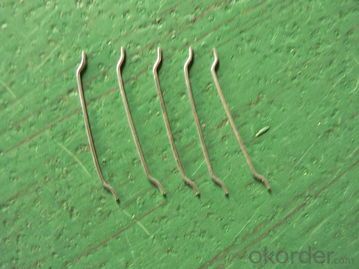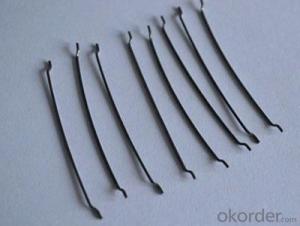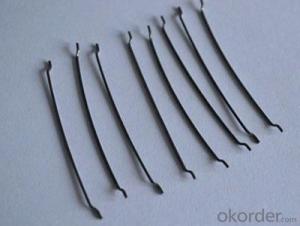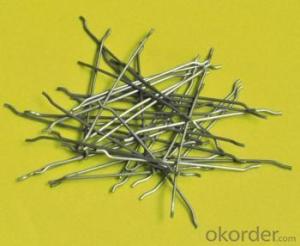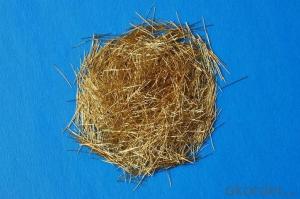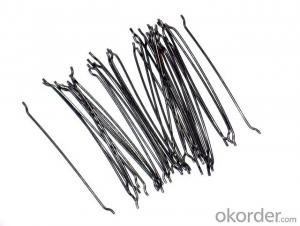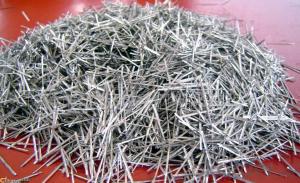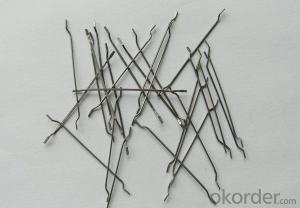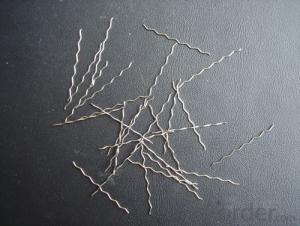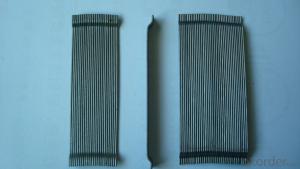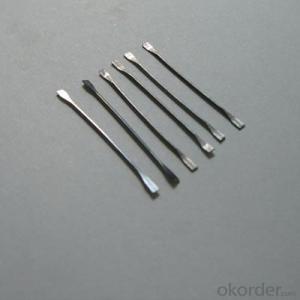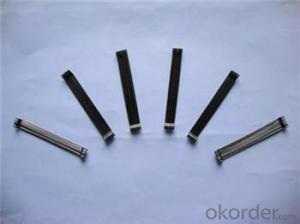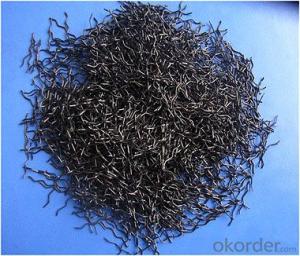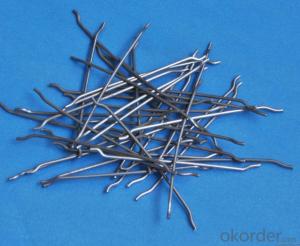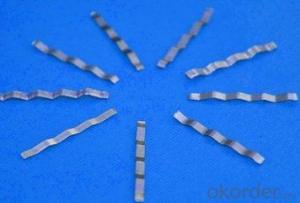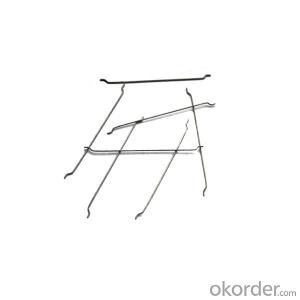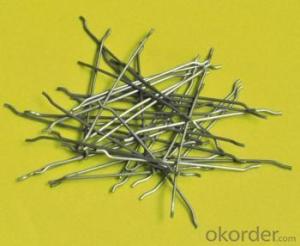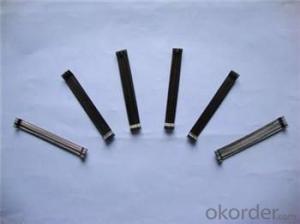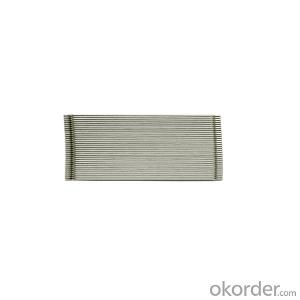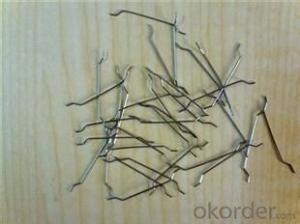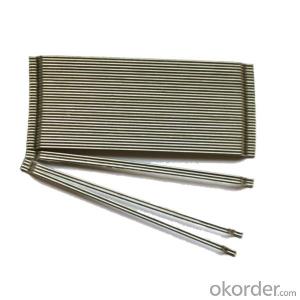Melt Extract Stainless Steel Fiber Wavy for Construction and Concrete
- Loading Port:
- Tianjin
- Payment Terms:
- TT OR LC
- Min Order Qty:
- 5000 kg
- Supply Capability:
- 250000 kg/month
OKorder Service Pledge
OKorder Financial Service
You Might Also Like
Quick Details
material: steel wire
shape: corrugated round fiber
appearance: clean and bright
usage: construction and concrete
Place of Origin: Shandong, China (Mainland)
Model Number: steel fiber
Product features
steel iber for concrete reinforcement ,it`s widely used in buildings ,bridges ,thin roof engineering ,highway etc
cncrete steel iber is specificially designed to enhance concrete in its hardened state ,the uniform distribution of steel fibers throughout the concrete greatly improves concrete bonding and tensile strength ,additionally it provides exceptional load stability and durability ,as reliable and efficient concrete reinforcement material .
it is widely used in buildings ,bridges ,thin roof engineering ,highway etc.
Specifications
Length :20-60mm
Diameter :0.5-1.2
Tensile strength:600Mpa-900Mpa
Appearance :clear and bright steel wire
Style :corrugated round fiber
Picture
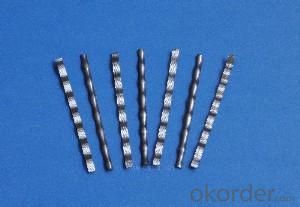
FAQ
we can produce any type steel fiber and of course we can make production according to your requirement
we have specilize in this field for almost 10 years ,with good quality and competitive price
- Q: Does melt extract stainless steel fiber enhance the crack resistance of concrete?
- Concrete's crack resistance is enhanced by melt extract stainless steel fiber. To improve the tensile strength and prevent crack formation and propagation, stainless steel fibers are added to concrete mixes. Acting as reinforcement within the concrete matrix, these fibers provide additional strength and durability. When evenly dispersed throughout the concrete, these fibers form a three-dimensional network that helps distribute stress and load more uniformly. This reduces the likelihood of cracks forming and spreading, ultimately enhancing the concrete's overall crack resistance. Melt extract stainless steel fibers possess a high melting point and excellent corrosion resistance, making them highly effective in harsh environments or when exposed to chemicals. These fibers can endure high temperatures and prevent spalling or cracking of the concrete under extreme conditions. Moreover, the inclusion of stainless steel fibers improves the impact resistance and flexural strength of the concrete, rendering it more resilient to cracking caused by external forces or dynamic loads. In summary, melt extract stainless steel fiber positively contributes to the crack resistance of concrete by reinforcing the material and enhancing its tensile strength. Consequently, this leads to a more enduring and long-lasting concrete structure.
- Q: How does melt extract stainless steel fiber affect the shrinkage and creep of concrete?
- Melt extract stainless steel fiber has a positive impact on both shrinkage and creep of concrete. The addition of these fibers helps to reduce the overall shrinkage of concrete, resulting in less cracking and improved durability. Additionally, these fibers enhance the resistance to creep, which is the deformation that occurs over time under sustained load. By mitigating shrinkage and creep, melt extract stainless steel fiber contributes to the enhanced performance and longevity of concrete structures.
- Q: Is melt extract stainless steel fiber compatible with different types of shotcrete accelerators?
- Different types of shotcrete accelerators can be used with melt extract stainless steel fiber, as they are compatible. Shotcrete accelerators are employed to quicken the setting and hardening processes of shotcrete or concrete. To enhance the mechanical properties and durability of the final product, melt extract stainless steel fibers are frequently incorporated into shotcrete mixes. These fibers, made from stainless steel, possess exceptional corrosion resistance, allowing them to be compatible with various shotcrete accelerators. The inclusion of melt extract stainless steel fibers can bolster the bond strength, crack resistance, and impact resistance of shotcrete, regardless of the accelerator type. Thus, it is safe to assert that melt extract stainless steel fiber is compatible with different types of shotcrete accelerators.
- Q: What is the effect of melt extract stainless steel fiber on the permeability of shotcrete?
- The effect of melt extract stainless steel fiber on the permeability of shotcrete is to significantly reduce or eliminate the permeability altogether. Shotcrete is a construction material that is commonly used for applications such as tunnel linings, retaining walls, and slope stabilization. Permeability refers to the ability of a material to allow the passage of fluids or gases through its pores or cracks. When melt extract stainless steel fibers are added to shotcrete, they create a dense network within the material. This network acts as reinforcement and helps to improve the overall strength and durability of the shotcrete. Additionally, the stainless steel fibers fill any voids or cracks in the shotcrete, reducing its permeability and preventing the ingress of water, gases, or other substances. The melt extract stainless steel fibers also enhance the cohesion and bonding of the shotcrete, improving its resistance to cracking and spalling. This is particularly beneficial in applications where the shotcrete is exposed to harsh environmental conditions or high levels of moisture. Overall, the addition of melt extract stainless steel fibers to shotcrete has a positive effect on its permeability, making it a more reliable and durable construction material. This improvement in permeability helps to enhance the performance and lifespan of shotcrete structures, ensuring their long-term integrity and functionality.
- Q: Can melt extract stainless steel fiber be used in the construction of power plant structures?
- Yes, melt extract stainless steel fiber can be used in the construction of power plant structures. These fibers are known for their high temperature resistance, corrosion resistance, and durability, making them suitable for applications in power plants where extreme conditions such as high temperatures, pressure, and chemicals are present. They can enhance the strength and performance of concrete and other construction materials used in power plant structures, providing added reinforcement and ensuring long-term structural integrity.
- Q: What is the effect of melt extract stainless steel fiber on the creep of concrete?
- The effect of melt extract stainless steel fiber on the creep of concrete is that it reduces the overall creep deformation of the concrete. This is due to the high tensile strength and ductility of stainless steel fiber, which helps to distribute and resist the applied load more effectively. Additionally, the inclusion of stainless steel fiber enhances the overall crack resistance of concrete, thereby reducing the potential for creep deformation.
- Q: Can melt extract stainless steel fiber be used in precast tunnel invert segments?
- Precast tunnel invert segments can indeed utilize melt extract stainless steel fiber. This type of stainless steel fiber is commonly employed in precast concrete applications to bolster the concrete's mechanical properties and endurance. By offering exceptional crack resistance, impact resistance, and ductility, it significantly enhances the concrete's overall performance. Due to its high tensile strength and corrosion resistance, melt extract stainless steel fiber is particularly well-suited for deployment in challenging environments like tunnels. Its utilization aids in the enhancement of flexural strength and load-bearing capacity in precast tunnel invert segments, thereby guaranteeing their long-term structural integrity. Moreover, the inclusion of stainless steel fiber can also diminish the necessity for traditional reinforcement, streamlining the production process and reducing expenses.
- Q: What is the lifespan of melt extract stainless steel fiber in concrete structures?
- The lifespan of melt extract stainless steel fiber in concrete structures can vary depending on various factors such as the quality of the fiber, the exposure conditions, and the overall maintenance of the concrete structure. However, on average, melt extract stainless steel fibers can have a lifespan of around 30 to 50 years in concrete structures.
- Q: Can melt extract stainless steel fiber be used in architectural precast cladding?
- Certainly, architectural precast cladding can make use of melt extract stainless steel fiber. Due to their exceptional strength, durability, and resistance to corrosion, stainless steel fibers are widely employed in architectural applications. These fibers can greatly enhance the tensile and flexural strength of precast cladding, minimize cracking, and bolster its resistance to impact and abrasion. Moreover, stainless steel fibers provide design flexibility and can be seamlessly integrated into the concrete mixture without compromising its workability. As a result, the incorporation of melt extract stainless steel fiber in architectural precast cladding can significantly enhance the lifespan and functionality of the cladding system.
- Q: Can melt extract stainless steel fiber be used in residential driveway pavements?
- Residential driveway pavements can benefit from the use of melt extract stainless steel fiber. It is common to incorporate stainless steel fibers into concrete applications to enhance strength, durability, and resistance to cracking. Adding these fibers to the concrete mix improves performance and longevity. Melt extract stainless steel fiber offers numerous advantages for residential driveway pavements. Firstly, it helps minimize cracks and surface defects caused by heavy vehicle traffic or changes in weather conditions. By reinforcing the concrete, the fibers make it more resistant to shrinkage, expansion, and cracking. Furthermore, stainless steel fibers enhance the overall strength of the concrete, increasing its load-bearing capacity. This is especially crucial for driveways that need to withstand the weight of vehicles and regular usage. The fibers ensure that loads are distributed evenly across the pavement surface, reducing the risk of structural damage. In addition, stainless steel fibers are corrosion-resistant, guaranteeing the driveway's longevity. They remain unaffected by moisture, chemicals, or other environmental factors that can lead to deterioration. This makes them an ideal choice for residential driveways, which are exposed to various conditions. In conclusion, melt extract stainless steel fiber is a valuable addition to residential driveway pavements. It enhances the strength and durability of the concrete, reduces cracking, and extends the lifespan of the driveway. Homeowners can rely on stainless steel fibers to keep their driveways in excellent condition for years to come.
Send your message to us
Melt Extract Stainless Steel Fiber Wavy for Construction and Concrete
- Loading Port:
- Tianjin
- Payment Terms:
- TT OR LC
- Min Order Qty:
- 5000 kg
- Supply Capability:
- 250000 kg/month
OKorder Service Pledge
OKorder Financial Service
Similar products
Hot products
Hot Searches
Related keywords



